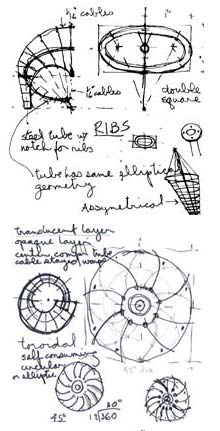Design Philosophy
 I owe a debt of gratitude to the constructivists who have gone before me and especially to my mentor Harry Weese. It was from him that I learned that structure can be architecture or in this case sculpture. I also learned that the inherent properties of materials can be explored and emphasized to enhance their qualities. Tension, compression, opacity, transparency, translucency, and curvability are all properties I seek to explore in my work. My career in architecture has given me a logical constructivist approach to sculpture, The skeletal and tensile facets of my work stem from the early introduction I had to the first aircraft displayed at the Smithsonion while working at the outset of the Washington Metro. The skeletal and tensile characteristics of my work derives from the observation that the underlying structure can be infinitely more interesting than its cladding or skin. Tensile and compressive members lend a dynamism to the composition while obscure meaning can add an extra dimension to the three that are physical. Elementary geometry pervades much of the work with a conscious effort to combine this geometry in an unconventional way. Construction of these pieces relies heavily on using appropriate materials which include sheet acrylic for its transparency, translucency and curvability; thin Finnish plywood for its warmth and curvability; aircraft cable for its tensile strength; steel and aluminum for their strength and compressibility and aniline dye for the introduction of color. The scale of most of my work is intended for indoor display. However, I think of these pieces as finished maquettes for larger scale outdoor work.
I owe a debt of gratitude to the constructivists who have gone before me and especially to my mentor Harry Weese. It was from him that I learned that structure can be architecture or in this case sculpture. I also learned that the inherent properties of materials can be explored and emphasized to enhance their qualities. Tension, compression, opacity, transparency, translucency, and curvability are all properties I seek to explore in my work. My career in architecture has given me a logical constructivist approach to sculpture, The skeletal and tensile facets of my work stem from the early introduction I had to the first aircraft displayed at the Smithsonion while working at the outset of the Washington Metro. The skeletal and tensile characteristics of my work derives from the observation that the underlying structure can be infinitely more interesting than its cladding or skin. Tensile and compressive members lend a dynamism to the composition while obscure meaning can add an extra dimension to the three that are physical. Elementary geometry pervades much of the work with a conscious effort to combine this geometry in an unconventional way. Construction of these pieces relies heavily on using appropriate materials which include sheet acrylic for its transparency, translucency and curvability; thin Finnish plywood for its warmth and curvability; aircraft cable for its tensile strength; steel and aluminum for their strength and compressibility and aniline dye for the introduction of color. The scale of most of my work is intended for indoor display. However, I think of these pieces as finished maquettes for larger scale outdoor work.